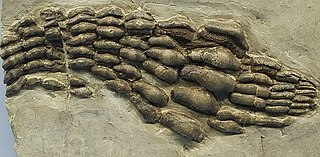
The Early Triassic is the first of three epochs of the Triassic Period of the geologic timescale. It spans the time between 251.9 Ma and 247.2 Ma. Rocks from this epoch are collectively known as the Lower Triassic Series, which is a unit in chronostratigraphy.

In the geologic timescale, the Olenekian is an age in the Early Triassic epoch; in chronostratigraphy, it is a stage in the Lower Triassic series. It spans the time between 251.2 Ma and 247.2 Ma. The Olenekian is sometimes divided into the Smithian and the Spathian subages or substages. The Olenekian follows the Induan and is followed by the Anisian.

The Induan is the first age of the Early Triassic epoch in the geologic timescale, or the lowest stage of the Lower Triassic series in chronostratigraphy. It spans the time between 251.9 Ma and 251.2 Ma. The Induan is sometimes divided into the Griesbachian and the Dienerian subages or substages. The Induan is preceded by the Changhsingian and is followed by the Olenekian.

Fulgurotherium is a dubious genus of ornithischian dinosaur from the Late Cretaceous (Cenomanian) Griman Creek Formation. It lived in what is now Australia.
Anasibirites is an extinct genus of ammonoid cephalopod from the lower upper Smithian Wasatchites distractus Zone.

Acrodus is an extinct genus of hybodont spanning from the Early Triassic to the Late Jurassic. It was durophagous, with blunt, broad teeth designed for crushing and grinding. Some Middle Triassic species have been suggested to have grown to lengths of 1.8–2.5 metres (5.9–8.2 ft). Species are known from both marine and freshwater environments, with all Middle and Late Jurassic species only known from freshwater.
Leonard Frank Spath FRS was a British geologist specialising in malacology and ammonitology.

Cynohyaenodon is an extinct paraphyletic genus of placental mammals from extinct family Hyaenodontidae that lived from the early to middle Eocene in Europe.
The Virgin Formation is a geologic formation in Utah. It preserves fossils dating back to the Triassic period.
The Vikinghøgda Formation is a geologic formation in Svalbard, Norway. It preserves fossils dating back to the Early Triassic (Griesbachian-Spathian) period. It is split into three members, from oldest to youngest: the Deltadalen Member (Induan), Lusitaniadalen Member (Smithian), and Vendomdalen Member (Spathian). The formation can be found in central Spitsbergen, southern Spitsbergen, as well as the smaller islands of Barentsøya and Edgeøya. The type locality is positioned in the vicinity of Vikinghøgda and Sticky Keep, two low peaks along the southeast edge of Sassendalen in Spitsbergen. The two upper members of the Vikinghøgda Formation were previously grouped together as the Sticky Keep Formation.
Paragoceratidae is an extinct family of ammonoids in the superfamily Dinaritoidea.
Corongoceras is a genus of ammonites in the family Himalayitidae.
Protomonaxonida is an extinct order of sea sponges. It is a paraphyletic group gathering the most ancient species from the Burgess Shale to modern sponges.
This list 2019 in paleomalacology is a list of new taxa of ammonites and other fossil cephalopods, as well as fossil gastropods, bivalves and other molluscs that are scheduled to be described during the year 2019, as well as other significant discoveries and events related to molluscan paleontology that are scheduled to occur in the year 2019.

Luohuilinella is an extinct genus of xandarellid artiopodan arthropod known from the Chengjiang biota of China. The type species Luohuilinella rarus was described in 2012. A second species Luohuilinella deletres was described in 2018. Both taxa are rare components of the assemblage. Like other Xandarellids and most artiopodans, it possessed an unmineralised exoskeleton. The type and currently only known specimen of L. rarus is known from a dorsal exoskeleton, around 17 mm long and 9 mm wide which consists of 27 tergites with pronounced pleural spines. L. deletres is much larger, with specimens being over 10 cm long, L. deletres possessed at least 11 pairs of biramous appendages. Both taxa are dorsoventrally flattened, making a benthic or nektobenthic lifestyle probable. Both taxa have pronounced notches in the cephalon to accommodate the stalked eyes.
The Xiaowa Formation is a Carnian-age geological formation found in southern China. It is a sequence of limestone and marls from the Carnian stage of the Triassic. Its lower section was previously known as the Wayao Formation or Wayao Member of the Falang Formation. In 2002, the Wayao Member was renamed and raised to the Xiaowa Formation to prevent confusion with an Eocene unit of the same name. Crinoids and marine reptiles are abundant in the Xiaowa Formation, forming a lagerstätte known as the Guanling biota. Ammonoids and conodonts found in the formation constrain its age to the early Carnian. Reptiles of the Guanling biota include ichthyosaurs, thalattosaurs, placodonts, and Odontochelys. Sedimentary events within this formation have been tied to the Carnian Pluvial Event.
The Guiyang biota is an exceptionally preserved Early Triassic fossil assemblage from the Daye Formation near Guiyang (China), discovered between 2015 and 2019 and first reported in 2023. It is the oldest known Mesozoic lagerstätte, and it provides evidence of the existence of a complex marine ecosystem shortly after the Permian–Triassic extinction event.
The Paris biota is an exceptionally diverse Early Triassic fossil assemblage described in 2017 from the Lower Shale Member of the Thaynes Group. It was first discovered in Paris Canyon, west of the town of Paris in Bear Lake County, southeastern Idaho, United States. This biota was later also found in coeval and slightly younger beds in northeastern Nevada and Bear Lake and Caribou counties, southeastern Idaho.
Triassosculda is an extinct genus of mantis shrimp from the Early Triassic aged Paris biota of Idaho. Its discovery bridged a 100-million-year gap in mantis shrimp evolution from the late Carboniferous to the Jurassic. Its only species is T. ahyongi.







